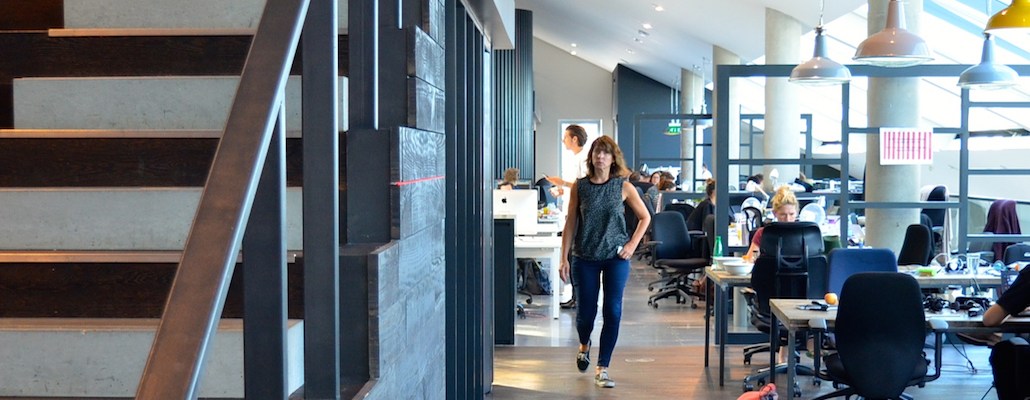Save 50% on a 3-month Digiday+ membership. Ends Dec 5.

Leo Rayman’s copy of “Creativity Inc,” the book by Pixar president Ed Catmull, is covered in marginalia.
Like a student jotting down notes around the edges of his text, the newly appointed CEO of Grey London wants to master the formula of good ideas. According to him, they are as much about the process as the end product.
“It’s really important to spend as much time talking about how we work and the culture we try and foster,” he said. “You can’t really get to wonderful new shapes of creativity without the cultural environment.”
With a staff of 470, the WPP-owned agency has doubled in size over the past seven years. Grey credits this to a cultural overhaul, which added an open-plan space and an “open” structure that gives teams more autonomy to reduce bottlenecks with senior staff.
Rayman says teams collaborate and shift in size “like jellyfish” according to each project’s needs. Now, he’s keen to widen the pool and bring in talent beyond its black book. His focus right now is on data and customer experience management; he is also eager to identify people who can help the agency better measure its success.

“Talent should come from all sorts of places. If you’re talking to the whole planet, you want a broad understanding,” Rayman said.
Ad position: web_incontent_pos1
Part of the draw for these new staff members is the social side of the agency. Perks include free beauty treatments and weekly treats, which range from bacon sandwiches to fruit smoothies. There’s also a cafe-bar downstairs that serves free drinks from 6 to 9 p.m. every Thursday.
“Like all agencies, there’s a certain amount of churn, so we’re constantly telling our story. Our free bar nights let people invite two friends from outside office, so it’s a really nice draw for meeting people,” Rayman said.

On each floor, there are collaborative office playlists run by self-appointed office DJs. Staffers can email in their requests. Email, in fact, is at the heart of the office’s broader culture. There are caption competitions for photos, and the company runs regular newsletters like the explainer series “WTF” and “Digidrop,” which is about new apps on the market. The agency is also looking to take its content public, with a podcast series about culture now in the works.
With diversity in mind, the agency strips out university and college history from resumes as part of its application process. Its intern program sees three new recruits every month and during Cannes; the agency replaced its creatives with three teams of young female interns. Each month, a different intern is tasked with promoting the office tuck shop, which donates its proceeds to charity.
Ad position: web_incontent_pos2

The office is covered in work from Grey’s employees. Downstairs hangs a series of brightly colored prints made by different members of the team. Each is inspired by a different statistic about homelessness. There’s also more ad-hoc work too, with posters taped up showing pitch-related puns.
While the agency’s bread and butter is TV and print ads for FMCGs. Rayman also wants to produce campaigns that are less sappy and populist, campaigns that don’t revolve around making “middle England cry.” This includes the agency’s recent work with Volvo, which created a luminous spray that rendered cyclists visible in low light and the eco-friendly font Grey designed for stationery brand Ryman to help users save ink.
Rayman likes the 70/20/10 rule, which states that companies should invest 70 percent of their resources in things they know work, 20 in new things that have been tested and 10 in the unknown. The Volvo spray would come in the 10 percent category.
Most of these ideas are formulated in the mingling between subject areas. There’s space in the office where anyone can drop in and play with new tech, be it the Amazon Echo speaker or Google’s Tilt Brush, a wearable headset and motion sensor that lets you draw 3D pictures in virtual reality.
“The challenge is finding enough people who can articulate it in a way that everyone can understand,” he said.



More in Marketing

Ulta, Best Buy and Adidas dominate AI holiday shopping mentions
The brands that are seeing the biggest boost from this shift in consumer behavior are some of the biggest retailers.

U.K. retailer Boots leads brand efforts to invest in ad creative’s data layer
For media dollars to make an impact, brands need ad creative that actually hits. More CMOs are investing in pre- and post-flight measurement.

‘AI is permeating everything we do’: How Guitar Center developed 2 AI tools this year
This summer, the company launched a chatbot called Rig Advisor to help customers find the right instruments and products.
Ad position: web_bfu